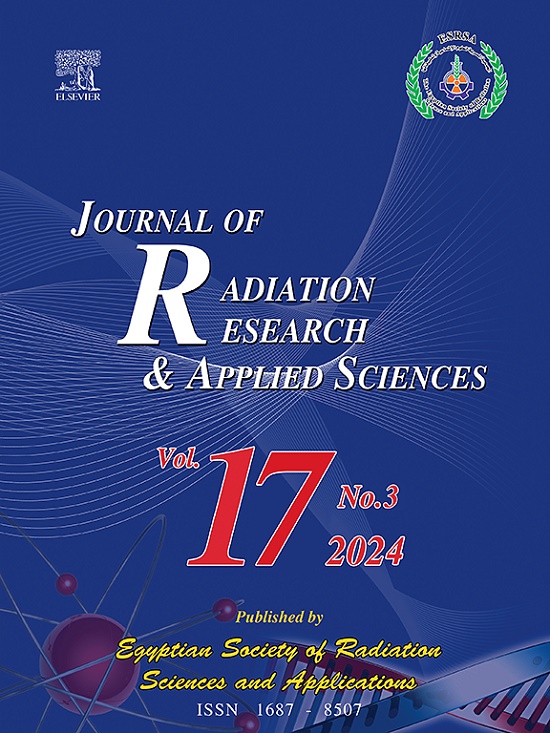The relationship between shoulder radiation dose and impairment in breast cancer patients: A prospective study using three-dimensional conformal radiotherapy
IF 1.7
4区 综合性期刊
Q2 MULTIDISCIPLINARY SCIENCES
Journal of Radiation Research and Applied Sciences
Pub Date : 2025-05-29
DOI:10.1016/j.jrras.2025.101646
引用次数: 0
Abstract
Introduction
Although regional nodal irradiation (RNI) increases the radiation dose to the shoulder and may lead to functional limitations, the relationship between shoulder volume doses and morbidity remains unclear. This study examines the impact of breast cancer radiotherapy on shoulder function and explores dose-volume correlations with complications.
Methods
In this prospective cohort study, breast cancer patients receiving RNI through 3D conformal radiation therapy (3DCRT) were evaluated. Baseline assessments were conducted before radiotherapy, with follow-ups at least six months post-treatment. Evaluations included the q-DASH questionnaire, shoulder range of motion (ROM) assessments, and shoulder muscle strength measurements. Radiation doses to the shoulder were calculated using the treatment planning system. Dose-volume relationships with shoulder function were analyzed.
Results
A total of 50 patients were included with a median follow-up of 9 months (range 8–12 months). Radiotherapy with RNI resulted in statistically significant decreases in shoulder external rotation (mean difference: 2.76°, p = 0.011) and abduction ROM (mean difference: 6.70°, p = 0.004).
Mean shoulder volume-dose percentages for 5, 10, 20, 30, 40, 47.5, and 50 Gy were 85.18 %, 81.14 %, 75.11 %, 65.58 %, 22.57 %, 24.58 %, and 14.08 %, respectively. However, increased shoulder volume doses were not associated with worsening ROM in any movement. No significant differences in volume doses were observed between patients with significant versus non-significant ROM reductions (p > 0.05).
Conclusion
This study found that breast cancer radiotherapy using 3DCRT had minimal impact on shoulder function, with no significant relationship between shoulder volume doses and mobility or strength limitations. Shoulder complications were more likely related to surgical interventions than radiotherapy. Further studies are needed to clarify the impact of radiotherapy on shoulder morbidity.
乳腺癌患者肩部放射剂量与损伤的关系:一项使用三维适形放疗的前瞻性研究
虽然区域淋巴结照射(RNI)增加了肩部的辐射剂量并可能导致功能限制,但肩部体积剂量与发病率之间的关系尚不清楚。本研究探讨了乳腺癌放疗对肩关节功能的影响,并探讨了剂量-体积与并发症的相关性。方法本前瞻性队列研究对接受RNI的乳腺癌患者进行三维适形放射治疗(3DCRT)。放疗前进行基线评估,治疗后至少随访6个月。评估包括q-DASH问卷、肩部活动范围(ROM)评估和肩部肌肉力量测量。使用治疗计划系统计算肩部的辐射剂量。分析剂量-体积与肩功能的关系。结果共纳入50例患者,中位随访时间为9个月(8-12个月)。RNI放疗导致肩关节外旋(平均差值:2.76°,p = 0.011)和外展ROM(平均差值:6.70°,p = 0.004)降低,具有统计学意义。5、10、20、30、40、47.5、50 Gy的平均肩体积剂量百分比分别为85.18%、81.14%、75.11%、65.58%、22.57%、24.58%、14.08%。然而,肩部体积剂量的增加与任何运动中ROM的恶化无关。在ROM明显减少与非明显减少的患者之间,体积剂量没有显著差异(p >;0.05)。结论本研究发现,使用3DCRT进行乳腺癌放疗对肩关节功能的影响很小,肩关节体积剂量与活动能力或力量限制无显著关系。肩部并发症更可能与手术干预有关,而不是放疗。需要进一步的研究来阐明放疗对肩关节发病率的影响。
本文章由计算机程序翻译,如有差异,请以英文原文为准。
求助全文
约1分钟内获得全文
求助全文
来源期刊

Journal of Radiation Research and Applied Sciences
MULTIDISCIPLINARY SCIENCES-
自引率
5.90%
发文量
130
审稿时长
16 weeks
期刊介绍:
Journal of Radiation Research and Applied Sciences provides a high quality medium for the publication of substantial, original and scientific and technological papers on the development and applications of nuclear, radiation and isotopes in biology, medicine, drugs, biochemistry, microbiology, agriculture, entomology, food technology, chemistry, physics, solid states, engineering, environmental and applied sciences.
 求助内容:
求助内容: 应助结果提醒方式:
应助结果提醒方式:


